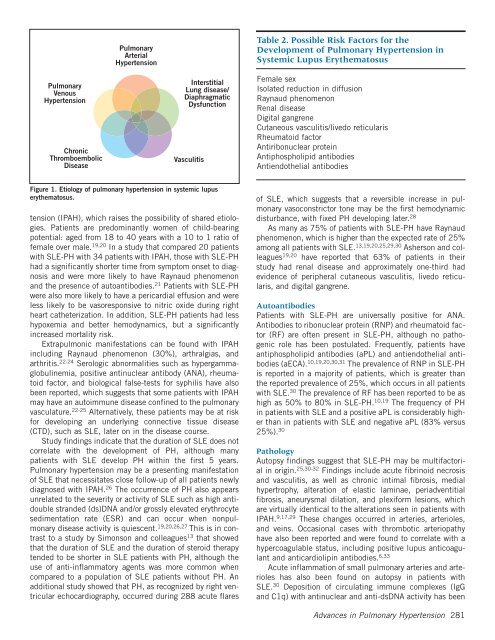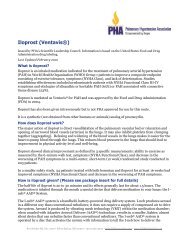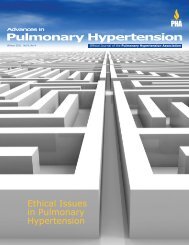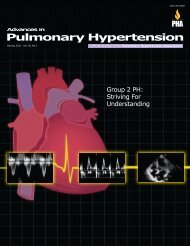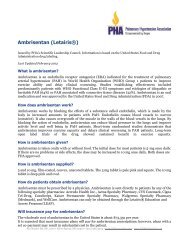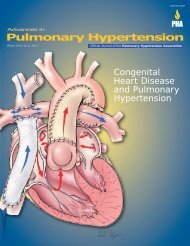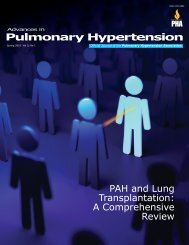Pulmonary Hypertension - PHA Online University
Pulmonary Hypertension - PHA Online University
Pulmonary Hypertension - PHA Online University
You also want an ePaper? Increase the reach of your titles
YUMPU automatically turns print PDFs into web optimized ePapers that Google loves.
<strong>Pulmonary</strong>Arterial<strong>Hypertension</strong>Table 2. Possible Risk Factors for theDevelopment of <strong>Pulmonary</strong> <strong>Hypertension</strong> inSystemic Lupus Erythematosus<strong>Pulmonary</strong>Venous<strong>Hypertension</strong>ChronicThromboembolicDiseaseInterstitialLung disease/DiaphragmaticDysfunctionVasculitisFemale sexIsolated reduction in diffusionRaynaud phenomenonRenal diseaseDigital gangreneCutaneous vasculitis/livedo reticularisRheumatoid factorAntiribonuclear proteinAntiphospholipid antibodiesAntiendothelial antibodiesFigure 1. Etiology of pulmonary hypertension in systemic lupuserythematosus.tension (IPAH), which raises the possibility of shared etiologies.Patients are predominantly women of child-bearingpotential: aged from 18 to 40 years with a 10 to 1 ratio offemale over male. 19,20 In a study that compared 20 patientswith SLE-PH with 34 patients with IPAH, those with SLE-PHhad a significantly shorter time from symptom onset to diagnosisand were more likely to have Raynaud phenomenonand the presence of autoantibodies. 21 Patients with SLE-PHwere also more likely to have a pericardial effusion and wereless likely to be vasoresponsive to nitric oxide during rightheart catheterization. In addition, SLE-PH patients had lesshypoxemia and better hemodynamics, but a significantlyincreased mortality risk.Extrapulmonic manifestations can be found with IPAHincluding Raynaud phenomenon (30%), arthralgias, andarthritis. 22-24 Serologic abnormalities such as hypergammaglobulinemia,positive antinuclear antibody (ANA), rheumatoidfactor, and biological false-tests for syphilis have alsobeen reported, which suggests that some patients with IPAHmay have an autoimmune disease confined to the pulmonaryvasculature. 22-25 Alternatively, these patients may be at riskfor developing an underlying connective tissue disease(CTD), such as SLE, later on in the disease course.Study findings indicate that the duration of SLE does notcorrelate with the development of PH, although manypatients with SLE develop PH within the first 5 years.<strong>Pulmonary</strong> hypertension may be a presenting manifestationof SLE that necessitates close follow-up of all patients newlydiagnosed with IPAH. 26 The occurrence of PH also appearsunrelated to the severity or activity of SLE such as high antidoublestranded (ds)DNA and/or grossly elevated erythrocytesedimentation rate (ESR) and can occur when nonpulmonarydisease activity is quiescent. 19,20,26,27 This is in contrastto a study by Simonson and colleagues 13 that showedthat the duration of SLE and the duration of steroid therapytended to be shorter in SLE patients with PH, although theuse of anti-inflammatory agents was more common whencompared to a population of SLE patients without PH. Anadditional study showed that PH, as recognized by right ventricularechocardiography, occurred during 288 acute flaresof SLE, which suggests that a reversible increase in pulmonaryvasoconstrictor tone may be the first hemodynamicdisturbance, with fixed PH developing later. 28As many as 75% of patients with SLE-PH have Raynaudphenomenon, which is higher than the expected rate of 25%among all patients with SLE. 13,19,20,25,29,30 Asherson and colleagues19,20 have reported that 63% of patients in theirstudy had renal disease and approximately one-third hadevidence of peripheral cutaneous vasculitis, livedo reticularis,and digital gangrene.AutoantibodiesPatients with SLE-PH are universally positive for ANA.Antibodies to ribonuclear protein (RNP) and rheumatoid factor(RF) are often present in SLE-PH, although no pathogenicrole has been postulated. Frequently, patients haveantiphospholipid antibodies (aPL) and antiendothelial antibodies(aECA). 10,19,20,30,31 The prevalence of RNP in SLE-PHis reported in a majority of patients, which is greater thanthe reported prevalence of 25%, which occurs in all patientswith SLE. 30 The prevalence of RF has been reported to be ashigh as 50% to 80% in SLE-PH. 10,19 The frequency of PHin patients with SLE and a positive aPL is considerably higherthan in patients with SLE and negative aPL (83% versus25%). 30PathologyAutopsy findings suggest that SLE-PH may be multifactorialin origin. 25,30-32 Findings include acute fibrinoid necrosisand vasculitis, as well as chronic intimal fibrosis, medialhypertrophy, alteration of elastic laminae, periadventitialfibrosis, aneurysmal dilation, and plexiform lesions, whichare virtually identical to the alterations seen in patients withIPAH. 9,17,29 These changes occurred in arteries, arterioles,and veins. Occasional cases with thrombotic arteriopathyhave also been reported and were found to correlate with ahypercoagulable status, including positive lupus anticoagulantand anticardiolipin antibodies. 6,33Acute inflammation of small pulmonary arteries and arterioleshas also been found on autopsy in patients withSLE. 30 Deposition of circulating immune complexes (IgGand C1q) with antinuclear and anti-dsDNA activity has beenAdvances in <strong>Pulmonary</strong> <strong>Hypertension</strong> 281


